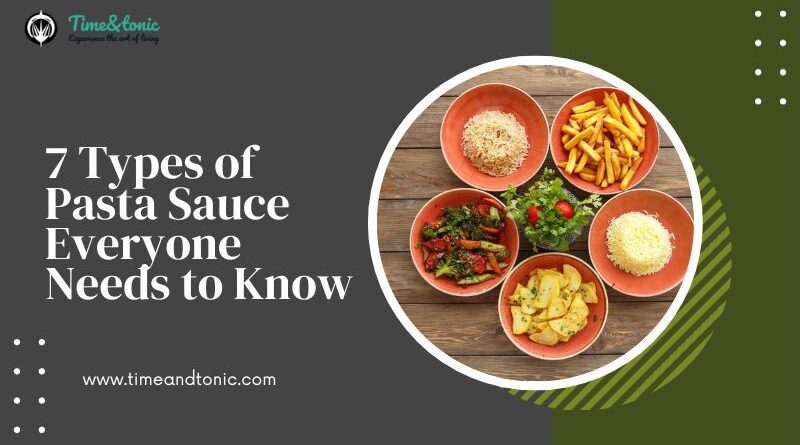7 Types of Pasta Sauce Everyone Needs to Know
Types of Pasta Sauce- Pasta, a timeless and beloved dish, owes much of its delectable appeal to one crucial element: the sauce. Whether you prefer the classic Italian marinara or enjoy indulging in creamy Alfredo, the world of pasta sauce is a universe unto itself, teeming with diverse flavors and traditions. In this comprehensive guide, we embark on a culinary journey to explore the myriad Types of Pasta Sauce that grace our plates.
Pasta’s universal appeal lies in its versatility, acting as the perfect canvas for an array of sauces that span the globe. From the heart of Italy to the far reaches of Asian fusion, we’ll delve into the ingredients, origins, and preparation methods that make each sauce unique.
But this guide isn’t just about recipes; it’s a celebration of culinary artistry. We’ll offer insights into the art of pairing pasta and sauce, ensuring your meals are a symphony of flavors. So, whether you’re a pasta novice or a seasoned chef, get ready to discover the saucy secrets that elevate this humble dish to culinary greatness.
What Makes Pasta So Special?
Pasta is a culinary marvel that has transcended generations and borders, earning its place as a beloved comfort food worldwide. Its universal appeal can be attributed to several key factors that make pasta undeniably special:
- Versatility: One of the most remarkable qualities of pasta is its versatility. It serves as a blank canvas, ready to absorb the flavors of various sauces and ingredients. This adaptability allows for an endless array of pasta dishes, from simple and comforting to gourmet and sophisticated.
- Ease of Preparation: Pasta is a quick and convenient meal option, making it a go-to choice for busy individuals and families. With a relatively short cooking time, even novice cooks can whip up a satisfying pasta dish without much effort.
- Affordability: Pasta is budget-friendly, making it accessible to people from all walks of life. Whether you choose dried or fresh pasta, it’s an economical choice that can be dressed up or down to suit any occasion.
- Long Shelf Life: Dried pasta has a long shelf life, making it a pantry staple that can be stored for extended periods without spoilage. This durability ensures that you always have a meal option on hand.
- Cultural Significance: Pasta holds a special place in the hearts of many cultures. It’s a symbol of comfort, tradition, and togetherness, often featured in family gatherings and celebratory feasts.
- Nutritional Value: Pasta provides a source of complex carbohydrates, offering sustained energy. It’s also a versatile platform for incorporating a wide range of vegetables, proteins, and healthy fats, allowing for balanced and nutritious meals.
- Endless Variety: Pasta comes in an astounding variety of shapes and sizes, each designed to complement specific sauces and dishes. This diversity in pasta types adds excitement to the dining experience.
- Global Appeal: Pasta has transcended its Italian origins to become a global favorite. Every culture has put its unique spin on pasta, resulting in an international tapestry of flavors and preparations.
Also, Read – Best Copycat Cheesecake Factory Recipes
Types of Pasta Sauce

Marinara Sauce
Marinara sauce is a classic Italian pasta sauce known for its simplicity and bold tomato flavor. It’s made by sautéing onions and garlic in olive oil, then simmering them with ripe tomatoes and a blend of aromatic herbs, including basil and oregano. This sauce is typically seasoned with salt and pepper to taste. The result is a bright red, slightly tangy sauce with a hint of sweetness, perfect for coating pasta like spaghetti or linguine.
Marinara sauce can also serve as a versatile base for many other Italian dishes, such as lasagna or pizza. It’s a quick and easy sauce to prepare, making it a favorite for home cooks and a staple in Italian cuisine.
Bolognese Sauce
Bolognese sauce, originating from Bologna, Italy, is a rich and savory meat sauce. It’s traditionally made by sautéing finely chopped onions, carrots, and celery in olive oil, then adding ground beef or pork. The meat is browned and simmered with tomatoes, wine, and milk or cream. This slow-cooked sauce develops a deep flavor as it melds the ingredients together.
Aromatic herbs like bay leaves and thyme are often added, along with a touch of nutmeg. The result is a thick, hearty sauce with a balanced combination of meatiness, sweetness from the tomatoes, and creaminess from the dairy. Bolognese sauce pairs wonderfully with pasta like fettuccine or tagliatelle, creating a comforting and satisfying Italian dish.

Alfredo Sauce
Alfredo sauce is a luxurious and creamy Italian pasta sauce. It’s made by gently melting butter and combining it with heavy cream, creating a rich base. Grated Parmesan cheese is added, creating a velvety, cheesy texture. Often seasoned with garlic, salt, and pepper, Alfredo sauce has a subtle yet flavorful taste. It’s commonly paired with fettuccine pasta, coating the noodles in its indulgent embrace.
This sauce is known for its simplicity, relying on just a few quality ingredients to achieve its signature decadence. Alfredo sauce is versatile and can be enhanced with ingredients like garlic, parsley, or shrimp for added depth and variety. It’s a favorite choice for those seeking a comforting and creamy pasta dish.
Also, Read – Best Squash Recipes
Pesto Sauce
Pesto sauce is a vibrant and aromatic Italian sauce with a basil-centric flavor profile. It’s crafted by blending fresh basil leaves, pine nuts, garlic, grated Parmesan cheese, and olive oil into a thick, green paste. The result is a sauce bursting with herbaceous, nutty, and garlicky notes. Pesto’s versatility extends beyond pasta, as it also makes a wonderful spread for sandwiches, a flavorful topping for grilled vegetables, or a dip for bread.
Traditionally, it’s mixed with pasta like spaghetti or linguine, creating a quick and delightful dish. The bright green color and intense flavor of pesto sauce make it a popular choice for those seeking a taste of Italian freshness and simplicity in their meals.
Carbonara Sauce
Carbonara sauce is a classic Italian pasta sauce known for its luscious creaminess and savory flavor. It originates from Rome and is made by combining eggs, Pecorino Romano cheese, and black pepper. The sauce is created by whisking these ingredients together until they form a creamy mixture. Typically, guanciale (cured pork cheek) or pancetta is sautéed until crispy and then mixed with the cooked pasta.
The hot pasta and pork create the perfect base for the sauce, as the residual heat from the pasta cooks the eggs slightly, resulting in a creamy, silky texture. Black pepper is added for a subtle spicy kick.
The simplicity of carbonara is its charm, with just a handful of ingredients combining to create a rich and indulgent sauce. When paired with spaghetti or bucatini, carbonara is a comforting and satisfying Italian classic that showcases the beauty of minimalism in cooking.
Arrabbiata Sauce
Arrabbiata sauce is a zesty and fiery Italian pasta sauce known for its bold flavors. This sauce starts with a base of tomatoes, garlic, and olive oil, providing a robust tomatoey foundation. What sets Arrabbiata apart is the addition of red chili peppers, which deliver a spicy kick. The name “Arrabbiata” translates to “angry” in Italian, referencing the sauce’s fiery heat.
To make Arrabbiata sauce, sauté garlic in olive oil until fragrant, then add crushed red pepper flakes for the signature spiciness. Simmer this mixture with tomatoes and season with salt, pepper, and sometimes fresh parsley or basil. The result is a vibrant and spicy sauce that pairs perfectly with pasta, like penne or spaghetti. Arrabbiata sauce offers a bold and fiery alternative to milder pasta sauces, adding excitement and heat to your Italian dishes.

Vodka Sauce
Vodka sauce is a creamy and indulgent Italian pasta sauce with a unique twist. It combines the richness of heavy cream and the tang of tomatoes with a touch of vodka for depth and flavor. To make vodka sauce, start by sautéing garlic and shallots in butter or olive oil. Then, add a splash of vodka to deglaze the pan, allowing the alcohol to cook off, leaving behind a subtle hint of its essence.
Next, mix in crushed tomatoes, heavy cream, and seasonings like red pepper flakes, salt, and pepper. Simmer until the sauce thickens and the flavors meld, resulting in a velvety, slightly pink-hued sauce.
Vodka sauce is often served with pasta, like penne or rigatoni, and offers a delightful combination of creaminess, acidity, and a mild kick from the vodka and red pepper flakes. It’s a luxurious option for those seeking a decadent Italian pasta experience.
Puttanesca Sauce
Puttanesca sauce is a bold and flavorful Italian pasta sauce known for its intense and savory taste. This sauce is made by sautéing garlic and red chili flakes in olive oil to create a fragrant base. Anchovies are then added for a deep umami flavor, along with capers and black olives, which contribute briny and salty notes. Chopped tomatoes and fresh basil are incorporated, and the sauce is simmered until it thickens and the flavors meld together.
The name “Puttanesca” is said to have originated from the Italian word “puttana,” which means “prostitute,” possibly due to its bold and spicy nature. Puttanesca sauce is often paired with spaghetti or other long pasta shapes, and it’s a quick and easy way to create a robust and pungent Italian dish with a hint of Mediterranean flair.
Aglio e Olio
Aglio e olio, which translates to “garlic and oil” in Italian, is a simple yet flavorful pasta sauce. This classic Italian sauce is made by sautéing thinly sliced garlic in olive oil until it becomes fragrant and slightly golden. Red pepper flakes are often added to infuse a subtle heat. The cooked pasta, typically spaghetti or linguine, is then tossed in this aromatic garlic and oil mixture.
Aglio e olio is renowned for its minimalistic approach to flavor, relying on the quality of the ingredients. It’s a quick and easy sauce to prepare, making it a favorite for busy weeknight dinners. The combination of garlic and olive oil creates a savory and aromatic coating for the pasta, allowing the flavors to shine through without overwhelming the dish. Fresh parsley and grated Parmesan cheese are often used as garnishes for added freshness and depth.

Clam Sauce
Clam sauce is a delightful Italian pasta sauce made with fresh clams as the star ingredient. There are two primary variations: white (bianco) and red (rosso).
White clam sauce is created by sautéing minced garlic in olive oil, adding fresh clams, white wine, and sometimes a touch of clam juice or fish stock. As the clams open and release their flavorful juices, the sauce forms a briny and aromatic base. A sprinkle of parsley and red pepper flakes adds freshness and a hint of heat. It’s commonly served with linguine or spaghetti, creating a light and seafood-infused pasta dish.
Red clam sauce includes tomatoes, transforming the sauce into a vibrant red hue. In addition to garlic and clams, it typically features crushed tomatoes, herbs like basil or oregano, and sometimes red pepper flakes for extra zest. This version pairs wonderfully with various pasta shapes, adding a tomato-rich depth to the dish.
Conclusion
In conclusion, pasta sauce is the soul of pasta dishes, transforming humble noodles into culinary masterpieces. From classic Italian varieties to global fusions, the world of pasta sauce is a flavorful adventure waiting to be explored. By understanding the nuances of different sauce types and mastering the art of pairing, you can elevate your pasta creations to new heights. So, whether you’re a pasta aficionado or just starting your pasta journey, embrace the diversity of pasta sauce, experiment with flavors, and savor every saucy bite. With pasta, there’s a world of delicious possibilities at your fingertips.
FAQs
Pasta sauce is a flavorful liquid or semi-liquid mixture that is typically served with pasta. It comes in various forms, including tomato-based sauces, cream-based sauces, and more, each offering a unique taste.
Some popular types of pasta sauce include marinara, Alfredo, pesto, bolognese, and carbonara. These sauces vary in ingredients, flavors, and origins.
No, pasta sauces are not limited to Italian cuisine. While Italy is famous for its pasta and sauces, many cultures around the world have their own unique pasta sauce creations, offering a diverse range of flavors.




